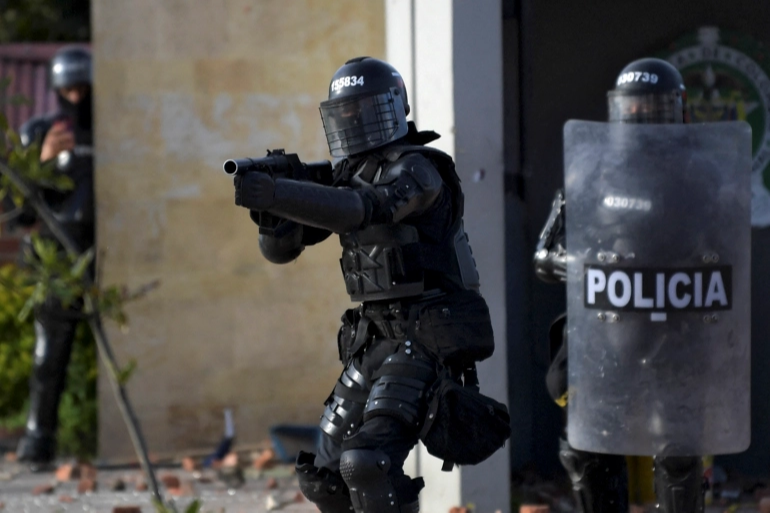
Riot police officers clash with demonstrators protesting against the government of Colombian President Ivan Duque in Bogota on June 29, 2021 [Raul Arboleda/AFP
Bogotá, July 30 (RHC)-- Colombian authorities unlawfully detained, tortured, and used lethal weapons against peaceful protesters during the demonstrations that have swept the country since April, said a new report from Amnesty International.
Through an “exhaustive digital verification” of images and videos, Amnesty also confirmed that National Police officials permitted acts of violence and urban paramilitarism by armed civilians against demonstrators and human rights activists.
The protests, which reached their peak in May, have since calmed, although they saw a resurgence on July 20, Colombian Independence Day. Since the beginning of the demonstrations, the National Police and the Mobile Anti-Riot Squad (ESMAD) have been criticised for excessive force and repression of peaceful protests. The largest protests took place in Cali, which has the largest Afro-descendant population in Colombia and the second largest in Latin America, and where racism, classism, as well as the country’s internal armed conflict have taken a toll.
The Amnesty report documented some of the worst of the allegations levelled against authorities. “[P]olice officers and armed civilians, acting with their acquiescence and tolerance, attacked the protesters, committing acts of torture in some cases,” the report argued. “[I]n a country battered by decades of paramilitary violence, these events are extremely serious and must be investigated diligently, independently and impartially.”
The report analyses, in particular, a violent police incursion into the Cali neighbourhood of Siloé, an attack on the Indigenous Minga by armed civilians as police looked on, as well as attacks by police and civilians against protesters at Valle University, where several demonstrators allege torture and inhumane treatment during their unlawful detention.
Three protesters described in detail how police beat them, pressured them to confess to crimes they had not committed, and threatened to “disappear” them.
These practices are not isolated incidents, but rather reflect a pattern of violent repression by Colombian authorities including President Iván Duque, who fuelled protests by sending military units “shaped by more than six decades of armed conflict” into city streets, the report concluded.
Amnesty’s report came three weeks after the Inter-American Commission on Human Rights (IACHR), an autonomous body in the Organization of American States, concluded the Colombian government used “excessive and disproportionate” force during the protests. The IACHR called on the government to make structural changes to its police force.
Human Rights Watch last month also called out “egregious” police abuse during the protests and demanded the government “take urgent measures to protect human rights”.
In an interview with Al Jazeera, the Amnesty report’s author, María José Veramendi, pointed to a pattern of police violence during the past two years, including the death of Dilan Cruz during protests in 2019 and Javier Ordoñez, whose death in police custody after being repeatedly tasered by officers sparked deadly protests last year.
An official source from the National Police pointed out the violence and destruction caused by protesters, pointed to proposed police reforms and stated that any crimes committed by police were isolated incidents and not representative of a systemic issue.
“While there were some policemen who were committing mistakes and abuses, which as I say should be punished with total severity, there is a difference,” the source wrote in a message.
“And that is that those gentlemen did not get up from their beds with the intention of murdering and assaulting, as those who caused the terrible excesses that the country experienced for weeks did in a premeditated way.”
Veramendi said that while Amnesty also made an effort to document crimes committed by demonstrators, that responses like this from authorities are an attempt to avoid accountability.
“Unfortunately, what we have seen is, every time when faced with this evidence of human rights violations the government immediately shifts the focus to blockages, attacks on the police, attacks on bus stations etc,” she said.
“And all of those harm and damages to public goods to bus stations to police stations, of course, they need to be duly investigated. But the government cannot shift the conversation and needs to address their responsibility for human rights violations.”
The report also made a series of recommendations including trying human rights violations in ordinary courts instead of military tribunals and to cease the stigmatisation of protesters and accusations of alliance with armed groups without evidence.
“What we found is that we see this [violence] with the intention of causing fear, and to cause these peaceful protesters to cease the protest,” said Veramendi. “And we’ve been seeing this, unfortunately, during the past three months of the national strike in Colombia.”
This police repression achieved its intended effect, to some extent, said Andres Carmona, a 25-year old resident of Melendez, one of Cali’s main protest points, who saw several friends killed and injured in the demonstrations.
“There are many people who suddenly do not have the same adrenaline to continue putting up with these things. And only the boys remain, the ones who were always ready to fight,” he told Al Jazeera by phone from Melendez.

